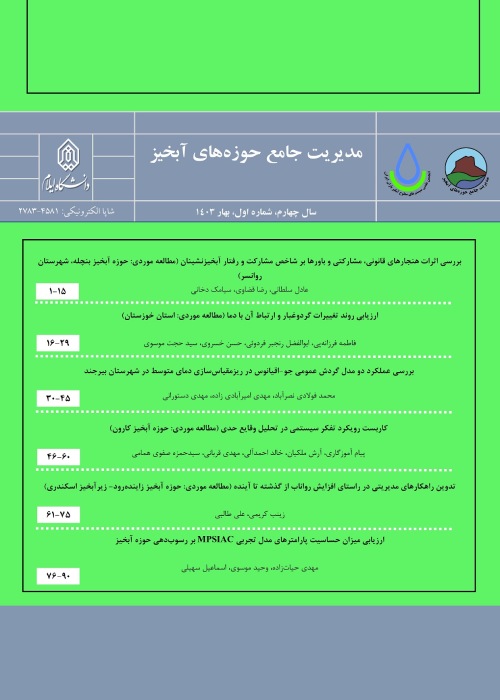Investigation of Wind Erosion Potential in Chahdashi Region of Nehbandan City, South Khorasan Province Using IRIFR.2 Model
Wind erosion causes land degradation in arid and semiarid regions and is a serious challenge for sustainable production and farmland management. Therefore, it is necessary to identify the factors affecting wind erosion and wind erosion potential in each area and use them in planning. Wind erosion conditions exist mainly in arid and semi-arid climates of Iran (large parts of the central and eastern regions) at the same time and in today's situation, it has intensified due to improper management.
In this research, in order to determine and estimate the wind erosion potential of Chahdashi region of Nehbandan city of South Khorasan province, IRIFR.2 model and capabilities and facilities of ArcGIS10.3 software have been used. Given that the IRIFR model calculates wind erosion potential in geomorphological facies, in this research, geomorphological facies of the region were identified using basic maps including topography, DEM, geology, vegetation, land use and field visits,. IRIFR.2 model is introduced to estimate erosion of arable lands. This model enables the user to estimate the wind erosion potential of the field according to the questionnaire, seeing the effects and signs on the soil and field surface. To determine the amount of wind erosion of agricultural lands In IRIFR. 2 model, 9 factors including sedimentology of soil texture or land sediment, topography and location of the studied lands, wind speed and continuity of strong or erosive winds, roughness or the degree of unevenness of soil surface, impact soil compressive strength and turbulence, soil moisture and irrigation conditions, salt content and type of salts in soil and irrigation water, density of vegetation and straw remaining over the ground surface, and farm management (planting patterns, presence of windbreaks around the field, crop rotation) were examined. The score of each factor was determined and the score of these factors was added together.The deposition potential was then determined. After calculating the amount of erosion, the classification of erosion intensity was determined and finally the sediment potential and erosion intensity were mapped in each facie.
In the study area, 22 facies were identified and the facies of Rig-e-Danehriz plain, with the code 3-3-2 and with 29.5%, have the highest percentage of area and the area of agricultural lands, rangelands and uncovered lands were respectively 0.33, 99.03 and 0.64% of the available rangeland plants of 13 plant types. Erosion intensity class in different facies varies from very high to very low. Field visiting showed that areas with very low erosion have high rock cover. In fact, there is no soil for erosion in these areas. Accordingly, Arable lands have less potential for erosion than other work units. The results of the quality status map of the wind erosion intensity of this model showed 5 classes, of which 8.3% of the area is in the very low class, 28.6% in the low class, and 57.5% in the middle class. Vegetation, surface gravel and hardened clay surface prevent wind erosion in these areas, 1.8% in high class and 3.8% in very high class, which mostly includes active sand dunes. The highest erosion intensity score is related to the landuse of ripple and silk hills with facies code 1-3-3 and with a total score of 9 factors equal to 107, Qualitatively, it is related to the severity of erosion and covers 3.8% of the area. Also, the lowest score of wind erosion intensity belongs to stone outcrop unit with 1-1-1 facies code and total score of 3.8, which is qualitatively characterized by very low erosion intensity and the area of this unit covers 1.5% of the area. Agricultural lands are in the low erosion intensity class in terms of erosion potential with 3.2 tons per hectare per year.
According to IRIFR.2 model, the main factors contributing to wind erosion in Chahdashi area are environmental factors because environmental factors (wind condition and vegetation) with the highest scores were identified as the main factor in most work units. The wind erosion potential of the studied area in all facies is more than the soil potential of the region (due to climatic and edaphic soil conditions), wind speeds more than 4 m/s and also the lack of vegetation and in some facies the presence of soil particles sensitive to erosion, are the most important reasons for wind erosion in the region. The rate of erosion in the hill facies is 86.3 tons per hectare, which is the highest among the geomorphological facies of the region. Due to the favorable conditions for wind erosion, especially the lack of adhesion between soil particles, this facies has a deposition rate of more than 6000 tons per square kilometer per year.
- حق عضویت دریافتی صرف حمایت از نشریات عضو و نگهداری، تکمیل و توسعه مگیران میشود.
- پرداخت حق اشتراک و دانلود مقالات اجازه بازنشر آن در سایر رسانههای چاپی و دیجیتال را به کاربر نمیدهد.



